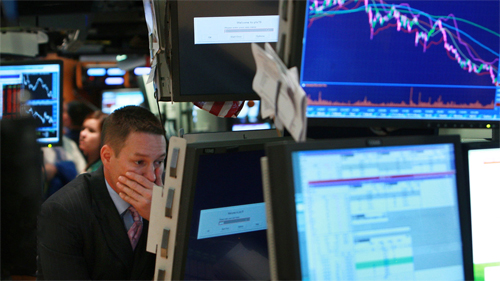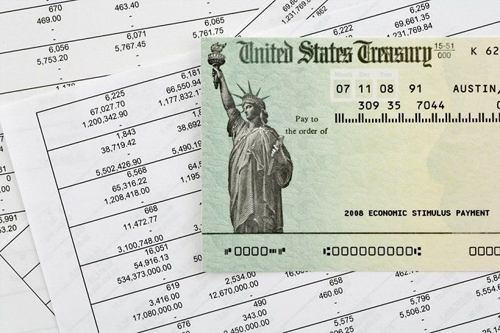Lockdowns, coronavirus, and banks: following the money (3)
Read the second part of the article
As usual, the poor get poorer
The original Chinese lockdowns in the winter of 2020 caused the breakdowns of import-export supply chains extending across the planet. Lockdowns in the movement of raw materials, parts, finished products, expertise, money and more shut down domestic businesses in China as well as transnational commerce in many countries outside China. The supply chain disruptions were especially severe for businesses that have dispensed with the practice of keeping on hand large inventories of parts and raw material, depending instead on just-in-time deliveries.

As the supply chains broke down domestically and internationally, many enterprises lacked the revenue to pay their expenses. Bankruptcies began to proliferate at rates that will probably continue to be astronomical for some time. All kinds of loans and liabilities were not paid out in full or at all. Many homes are being re-mortgaged or cast into real estate markets as happened during the prelude and course of the bailouts of 2007-2010.
The brunt of the financial onslaught hit small businesses especially hard. Collectively small businesses have been a big creator of jobs. They have picked up some of the slack from the rush of big businesses to downsize their number of full-time employees. Moreover, small businesses and start-ups are often the site of exceptionally agile innovations across broad spectrums of economic activity. The hard financial slam on the small business sector, therefore, is packing a heavy punch on the economic conditions of everyone.
The devastating impact of the economic meltdown on workers and small businesses in Europe and North America extends in especially lethal ways to the massive population of poor people living all over the world. Many of these poor people reside in countries where much of the paid work is irregular and informal.
At the end of April the International Labor Organization (ILO), an entity created along with the League of Nations at the end of the First World War, estimated that there would be 1.6 billion victims of the meltdown in the worldwide “informal economy.” In the first month of the crisis these workers based largely in Africa and Latin America lost 60% of their subsistence level incomes.
As ILO Director-General, Guy Ryder, has asserted, “This pandemic has laid bare in the cruellest way, the extraordinary precariousness and injustices of our world of work. It is the decimation of livelihoods in the informal economy – where six out of ten workers make a living – which has ignited the warnings from our colleagues in the World Food Programme, of the coming pandemic of hunger. It is the gaping holes in the social protection systems of even the richest countries, which have left millions in situations of deprivation. It is the failure to guarantee workplace safety that condemns nearly 3 million to die each year because of the work they do. And it is the unchecked dynamic of growing inequality which means that if, in medical terms, the virus does not discriminate between its victims in its social and economic impact, it discriminates brutally against the poorest and the powerless”.
Guy Ryder remembered the optimistic rhetoric in officialdom’s responses to the economic crash of 2007-2009. He compares the expectations currently being aroused by the vaccination fixation with the many optimistic sentiments previously suggesting the imminence of remedies for grotesque levels of global inequality. Ryder reflected, “We’ve heard it before. The slogan which provided the mood music of the crash of 2008-2009 was that once the vaccine to the virus of financial excess had been developed and applied, the global economy would be safer, fairer, more sustainable. But that didn’t happen. The old normal was restored with a vengeance and those on the lower echelons of labour markets found themselves even further behind.”
“The internationalization of increased unemployment and poverty brought about in the name of combating the corona crisis is having the effect of further widening the polarization between rich and poor on a global scale. Ryder’s metaphor about the false promises concerning a ‘vaccine’ to correct ‘financial excess’ can well be seen as a precautionary comment on the flowery rhetoric currently adorning the calls for a global reset.”
Wall Street and 9/11

The world economic crisis of 2020 is creating the context for large-scale repeats of some key aspects of the bailout of 2007-2010. The bailout of 2007-2008 drew, in turn, from many practices developed in the period when the explosive events of 9/11 triggered a worldwide reset of global geopolitics.
While the events of 2008 and 2020 both drew attention to the geopolitical importance of Wall Street, the terrible pummelling of New York’s financial district was the event that ushered in a new era of history, an era that has delivered us to the current financial meltdown/lockdown.
It lies well beyond the scope of this essay to go into detail about the dynamics of what really transpired on 9/11. Nevertheless, some explicit reckoning with this topic is crucial to understanding some of the essential themes addressed in this essay.
Indeed, it would be difficult to overstate the relevance of 9/11 to the background and nature of the current debacle. The execution and spinning of 9/11 were instrumental in creating the repertoire of political trickery presently being adapted in the manufacturing and exploiting of the Covid-19 hysteria. A consistent attribute of the journey from 9/11 to Covid-19 has been the amplification of executive authority through the medium of emergency measures enactments, policies and dictates.
Wall Street is a major site where much of this political trickery was concocted in planning exercises extending to many other sites of power and intrigue. In the case of 9/11, a number of prominent Wall Street firms were involved before, during and after the events of September 11. As is extremely well documented, these events have been misrepresented in ways that helped to further harness the military might of the United States to the expansionistic designs of Israel in the Middle East.
The response of the Federal Reserve to the events of 9/11 helped set in motion a basic approach to disaster management that continues to this day. Almost immediately following the pulverization of Manhattan’s most gigantic and iconographic landmarks, Federal Reserve officials made it their highest priority to inject liquidity into financial markets. Many different kinds of scenario can be advanced behind the cover of infusing liquidity into markets.
For three days in a row the Federal Reserve Bank of New York turned on its money spigots to inject transfusions of $100 billion dollars of newly generated funds into the Wall Street home of the financial system. The declared aim was to keep the flow of capital between financial institutions well lubricated. The Federal Reserve’s infusions of new money into Wall Street took many forms. New habits and appetites were thereby cultivated in ways that continue to influence the behaviour of Wall Street organizations in the financial debacle of 2020.
The revelations concerning the events of 9/11 contained a number of financial surprises. Questions immediately arose, for instance, about whether the destruction of the three World Trade Center skyscrapers had obliterated software and hardware vital to the continuing operations of computerized banking systems. Whatever problems arose along these lines, it turned out that there was sufficient digital information backed up in other locations to keep banking operations viable.
But while much digital data survived the destruction of core installations in the US financial sector, some strategic information was indeed obliterated. For instance, strategic records entailed in federal investigations into many business scandals were lost. Some of the incinerated data touched on, for instance, the machinations of the energy giant, Enron, along with its Wall Street partners, JP Morgan Chase and Citigroup.
The writings of E.P. Heidner are prominent in the literature posing theories about the elimination of incriminating documentation as a result of the controlled demolitions of 9/11. What information was eliminated and what was retained in the wake of the devastation? Heidner has published a very ambitious account placing the events of 9/11 at the forefront of a deep and elaborate relationship linking George H.W. Bush to Canada’s Barrick Gold and the emergence of gold derivatives.
The surprises involving 9/11 and Wall Street included evidence concerning trading on the New York Stock Exchange. A few individuals enriched themselves significantly by purchasing a disproportionately high number of put options on shares about to fall precipitously as a result of the anticipated events of 9/11. Investigators, however, chose to ignore this evidence because it did not conform to the prevailing interpretation of who did what to whom on 9/11.
Another suspicious group of transactions conducted right before 9/11 involved some very large purchases of five-year US Treasury notes. These instruments are well known hedges when one has knowledge that a world crisis is imminent. One of these purchases was a $5 billion transaction. The US Treasury Department would have been informed about the identity of the purchaser. Nevertheless the FBI and the Securities Exchange Commission collaborated to point public attention away from these suspect transactions. (p. 199)

On the very day of 9/11 local police arrested Israeli suspects employed in the New York area as Urban Movers. The local investigators were soon pressured to ignore the evidence, however, and go along with the agenda of the White House and the media chorus during the autumn of 2001. In the hours following the pulverization of the Twin Towers the dominant watchword was raised “Osama bin Laden and al-Qeada did it.” That led in the weeks, months and years that followed to US-led invasions of several Muslim-majority countries. Some have described these military campaigns as wars for Israel.
Soon New York area jails were being filled up with random Muslims picked up for nothing more than visa violations and such. The unrelenting demonization of Muslims collectively can now be seen in retrospect as a dramatic psychological operation meant to poison minds as the pounding of the war drums grew in intensity. In the process a traumatized public were introduced to concepts like “jihad.” At no time has there ever been a credible police investigation into the question of who is responsible for the 9/11 crimes. Defense Secretary Donald Rumsfeld chose September 10, the day before 9/11, to break the news at a press conference that $2.3 trillion had gone missing from the Pentagon’s budget. Not surprisingly the story of the missing money got buried the next day as reports of the debacle in Manhattan and Washington DC dominated MSM news coverage. As reported by Forbes Magazine, the size of the amount said to have gone missing in Donald Rumsfeld’s 2001 report of Defense Department spending had mushroomed by 2015 to around $21 trillion. It was Mark Skidmore, an Economics Professor at the University of Michigan, who became the main sleuth responsible for identifying the gargantuan amount of federal funds that the US government can’t account for.
As the agency that created the missing tens of trillions that apparently has disappeared without a trace, wouldn’t the US Federal Reserve be in a position to render some assistance in tracking down the lost funds? Or is the Federal Reserve somehow a participant or a complicit party in the disappearance of the tens of trillions without a paper trail?
The inability or unwillingness of officialdom to explain what happened to the lost $21 trillion, an amount comparable to the size of the entire US national debt prior to the lockdowns, might be viewed in the light of the black budgets of the US Department of Defense (DOD). Black budgets are off-the-books funds devoted to secret research and to secret initiatives in applied research.
In explaining this phenomenon, former Canadian Defense Minister, Paul Hellyer, has observed, “thousands of billions of dollars have been spent on projects about which Congress and the Commander In Chief have deliberately been kept in the dark.” Eric Zuess goes further. As he explains it, the entire Defense Department operates pretty much on the basis of an unusual system well outside the standard rules of accounting applied in other federal agencies.
When news broke about the missing $21 trillion, federal authorities responded by promising that special audits would be conducted to explain the irregularities. The results of those audits, if they took place at all, were never published. The fact that the Defense of Department has developed in a kind of audit free zone has made it a natural magnet for people and interests engaged in all kinds of criminal activities.
Eric Zuess calls attention to the 1,000 military bases around the world that form a natural network conducive to the cultivation of many forms of criminal trafficking. Zuess includes in his reflections commentary on the secret installations in some American embassies but especially in the giant US Embassy in Baghdad Iraq. The US complex in Baghdad’s Green Zone is the biggest Embassy in the world. Its monumental form on a 104 acre site expresses the expansionary dynamics of US military intervention in the Middle East and Eurasia following 9/11.
The phenomenon of missing tens of trillions calls attention to larger patterns of kleptocratic activity that forms a major subject addressed here. The shifts into new forms of organized crime in the name of “national security” began to come to light in the late 1980s. An important source of disclosures was the series of revelations that accompanied the coming apart of the Saudi-backed Bank of Credit and Commerce International, the BCCI. The nature of this financial institution, where CIA operatives were prominent among its clients, provides a good window into the political economy of drug dealing, money laundering, weapons smuggling, regime change and many much more criminal acts that took place along the road to 9/11.
The BCCI was a key site of financial transactions that contributed to the end of the Cold War and the inception of many new kinds of conflict. These activities often involved the well-financed activities of mercenaries, proxy armies, and a heavy reliance on private contractors of many sorts.
The Enron scandal was seen to embody some of the same lapses facilitated by fraudulent accounting integral to the BCCI scandal. Given the bubble of secrecy surrounding the Federal Reserve, there are thick barriers blocking deep investigation into whether or not the US Central Bank was involved in the relationship of the US national security establishment and the BCCI.
The kind of dark transactions that the BCCI was designed to facilitate must have been channeled after its demise into other banking institutions probably with Wall Street connections. Since 9/11, however, many emergency measures have been imposed that add extra layers of secrecy protecting the perpetrators of many criminal acts from public exposure and criminal prosecutions.
Read the fourth part of the article
yogaesoteric
November 10, 2020
